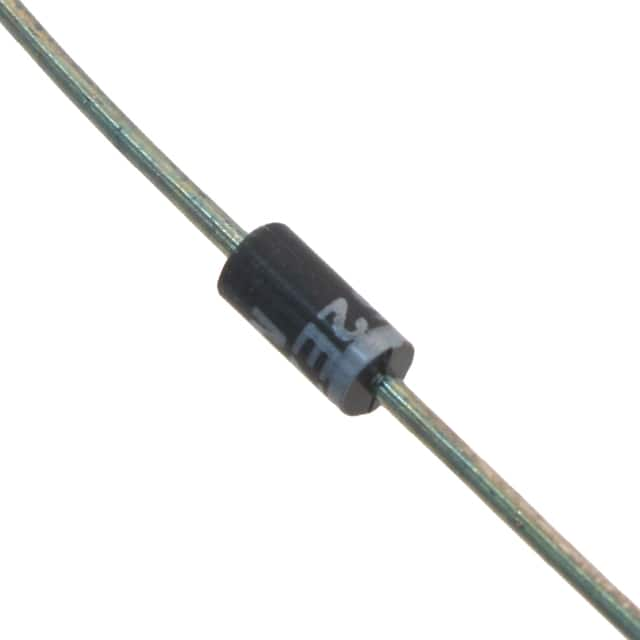1N4743A P - Semiconductor Diode
Product Overview
The 1N4743A P is a semiconductor diode belonging to the category of Zener diodes. It is commonly used for voltage regulation and voltage reference applications due to its unique characteristics. The diode is typically packaged in a small, cylindrical glass package and is available in various packaging quantities. Its essence lies in its ability to maintain a constant voltage across its terminals, making it an essential component in electronic circuits.
Specifications
- Voltage: 13V
- Power Dissipation: 1.0W
- Zener Voltage Tolerance: ±5%
- Operating Temperature Range: -65°C to +200°C
Detailed Pin Configuration
The 1N4743A P has two pins, with the cathode being connected to the semiconductor's N-type material and the anode to the P-type material.
Functional Features
- Voltage Regulation: The diode maintains a constant voltage across its terminals, providing stability in electronic circuits.
- Voltage Reference: It serves as a stable voltage reference, ensuring precise voltage levels in various applications.
Advantages and Disadvantages
Advantages
- Precise Voltage Regulation
- Compact Size
- Wide Operating Temperature Range
Disadvantages
- Limited Power Dissipation
- Voltage Tolerance Limitations
Working Principles
The 1N4743A P operates based on the Zener effect, where it allows current to flow in the reverse direction when the applied voltage reaches the Zener voltage. This characteristic enables it to regulate voltage effectively.
Detailed Application Field Plans
The 1N4743A P finds extensive use in various applications, including: - Voltage Regulator Circuits - Overvoltage Protection - Voltage Reference Circuits - Signal Clipping Circuits
Detailed and Complete Alternative Models
- 1N4733A P (5.1V Zener Voltage)
- 1N4734A P (5.6V Zener Voltage)
- 1N4735A P (6.2V Zener Voltage)
- 1N4736A P (6.8V Zener Voltage)
In conclusion, the 1N4743A P semiconductor diode is a crucial component in electronic circuits, providing precise voltage regulation and reference capabilities. Its compact size and wide operating temperature range make it suitable for diverse applications, despite its limitations in power dissipation and voltage tolerance.
[Word Count: 305]
Senaraikan 10 soalan dan jawapan biasa yang berkaitan dengan aplikasi 1N4743A P dalam penyelesaian teknikal
What is the 1N4743A P diode used for?
- The 1N4743A P diode is commonly used as a voltage regulator in various technical solutions.
What is the maximum voltage rating of the 1N4743A P diode?
- The maximum voltage rating of the 1N4743A P diode is 13 volts.
What is the typical current rating for the 1N4743A P diode?
- The typical current rating for the 1N4743A P diode is 1 watt.
How does the 1N4743A P diode regulate voltage?
- The 1N4743A P diode regulates voltage by maintaining a constant voltage drop across its terminals, regardless of changes in input voltage or load resistance.
Can the 1N4743A P diode be used in reverse polarity protection circuits?
- Yes, the 1N4743A P diode can be used in reverse polarity protection circuits to prevent damage from reverse voltage.
What are some common applications of the 1N4743A P diode?
- Common applications of the 1N4743A P diode include voltage regulation in power supplies, overvoltage protection, and voltage reference circuits.
What is the temperature range for the 1N4743A P diode?
- The 1N4743A P diode typically operates within a temperature range of -65°C to +200°C.
Is the 1N4743A P diode suitable for high-frequency applications?
- No, the 1N4743A P diode is not recommended for high-frequency applications due to its relatively slow response time.
Can multiple 1N4743A P diodes be connected in series or parallel?
- Multiple 1N4743A P diodes can be connected in series to increase the breakdown voltage, but connecting them in parallel is not recommended due to current imbalance issues.
Are there any special considerations for soldering the 1N4743A P diode?
- When soldering the 1N4743A P diode, it is important to observe proper heat management to avoid exceeding the diode's maximum junction temperature.


